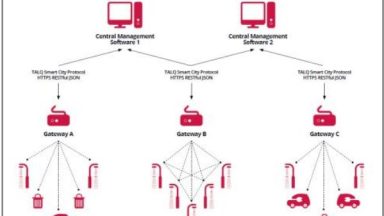As smart city models continue to evolve, it’s becoming increasingly evident that vendor tie-in is a growing concern. In light of this it’s important that smart cities are optimised by openness, not only in the interoperability of the smart devices and solutions that facilitate them, but in the approach regions and urban areas take to collaborate with technical partners.
A successful and intuitive smart city can’t be built independently. With resources already a challenge, it’s important to collaborate with internal teams, while ensuring external partners can deliver the solutions required to address specific and unique urban challenges.Working with technical specialists helps solve place-based problems effectively and overcomes some of the pain-points when it comes to building or further developing a smart city.
When seeking a technology partner to become optimised by openness and unlock urban insights, understanding their open credentials, as well as experience, is important. This ensures they can meet a well-defined and specific smart city challenge. However, with a growing list of internet of things (IoT), Software as a Service (SaaS) and Smart City specialists emerging throughout the UK and beyond, in a relatively new industry, this poses yet another challenge – finding the right partner to choose in order to build a solution that fits.
The below questions could help refine the selection process when it comes to finding a suitable collaboration partner that provides a truly open solution;
1. What experience does the solution provider have?
When choosing a technical collaborator or solution provider it’s beneficial to look at previous projects and collaborations, their success and learnings. Technology partners that have a history of collaboration are likely to have an understanding of the importance of open source data and the need for universal protocols to facilitate it.
2. Does the solution they are offering publish a set of easily consumable APIs to access data?
By providing this, it makes it possible to integrate new solutions within an internal system; such as a legacy asset management platform. This means that, regardless of function and application, the data generated will always tie back to existing data sets for a single lens view of smart city behaviour.
3. Does the solution have publicly accessible developer information?
This means that the solution can be adapted or new solutions can be developed, using developer information that is publicly accessible. By having information such as data format readily available, it means that solutions are futureproof as they can be easily be understood by other developers, should providers cease or discontinue service.
4. Does the proposed system communicate using a universally understood smart city protocol?
A universal smart city protocol defines a standard in the way smart city solutions can freely communicate with each other and integrate. Protocols such as TALQ v2 have been introduced so a number of interfaces can communicate with each other, as well as intelligent devices. This ensures interoperability within a universally understood specification that meets the requirements of openness.
5. Does the system meet modern security requirements?
To ensure open credentials are not compromised by poor security, many credible providers not only undergo peer review testing when developing code, their solutions and processes are also penetration tested by external companies, periodically.This ensures that the solutions they provide are not only compliant with the protocols and standards they strive to meet, it also validates the solution and it’s effectiveness.
6. Does the provider allow for data access and business continuity if anything was to happen through the continuity solutions provider?
The data all smart city solutions and systems produce is the most valuable asset. It is important to ensure that this data is available and accessible at all times, should anything happen to the technical collaborator providing the solution itself. Looking for specialists that work with SaaS Continuity solution providers is beneficial. Additionally, it is important to understand the measures in place should anything happen to the SaaS Continuity provider, to ensure data is not compromised at any time.
To find out more about beoming optimised by openness and why it is so important for the generation of actionable insights that truly inform smart city development, check out our Insights articles below.



